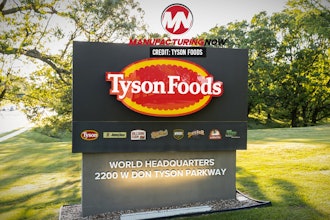
While still being released at a staggered pace, some compliance and enforcement deadlines for the Food Safety Modernization Act (FSMA) are finally seeing the light of day. With U.S. Food and Drug Administration (FDA) oversight, FSMA aims to ensure a safe food supply by enforcing legislation to prevent contamination. Its introduction caused food producers across North America to evaluate food processes and machinery, much of which required investment to meet the new law.
As a result of this legislation, food processors are placing an increased emphasis on hygienic design and machines made from stainless steel, which is easier to clean and resistant to harsh chemical cleaning products. In fact, nearly three out of four end users surveyed in the Trends in Food Processing Operations report, produced by PMMI, The Association for Packaging and Processing Technologies, cited cleanability as the number one machine improvement desired on new equipment.
These manufacturers are also embracing technology such as Clean-In-Place (CIP) and High Pressure Processing (HPP) to improve sanitation and food quality.
 Most companies involved in the food sector have a team of individuals closely evaluating machinery and production line operations, design and performance to assess all food safety risks and establish all critical control points.
Most companies involved in the food sector have a team of individuals closely evaluating machinery and production line operations, design and performance to assess all food safety risks and establish all critical control points.Keep It Clean
Most companies involved in the food sector have a team of individuals closely evaluating machinery and production line operations, design and performance to assess all food safety risks and establish all critical control points.
There are regulatory requirements for food processing equipment to be bacteria-free at the start of each process cycle. CIP systems are widely used to satisfy this requirement efficiently. These systems have effectively become an integral part of the manufacturing process and run after each cycle to clean and sanitize equipment. The developments with CIP have reinforced the increased integration of food processing and process control, as well as increased investment in software and automation in processing machinery.
Currently, FSMA does not have a mandatory validation requirement for CIP sanitation, but many consumer packaged goods (CPG) companies are taking this proactive approach to address food safety measures. The OpX Leadership Network recently released CIP for CPGs (Clean-in-Place Guidelines for Consumer Products Manufacturers) outlining generic definitions, equipment considerations and best practices for CIP that can be leveraged across multiple process lines. The newly released companion checklist provides assistance to operators and their teams in organizing, developing and validating a documented CIP plan for processing equipment.
First, the design of processing systems must include cleaning methods. It is important to remember that only correctly designed, installed and maintained systems can efficiently and consistently clean in place.
It is imperative for the safety of personnel and products, and for the longevity of equipment, to assure the entire team (operators, sanitation, maintenance, etc.) are all properly trained and aligned with the operational protocols and objectives of CIP.
According to CIP for CPGs, for a system to truly be cleanable in place it must abide by five rules:
- The unit operations and equipment components used in the system have been designed for CIP and have been verified to clean in place by 3-A-SSI, EHEDG, or an acceptable alternative method.
- Installation of the system must maintain its CIP integrity. This includes not only the materials and craftsmanship, but also the proper fluid dynamics for the CIP solution supply and return to the process equipment. (3A-SSI accepted practice 605 is a good guideline.)
- The process piping and equipment must be able to receive the prescribed flow, temperature, time, chemical concentration and pressure of cleaning solution required by the manufacturer or process design engineer. Often the process lines are not capable of delivering the CIP flow required by the equipment and additional design considerations are necessary. Active monitoring and adjustment of these critical process parameters throughout the cleaning cycle are important.
- Once a CIP process has been validated, proper change control procedures should be in place to maintain an accurate record of the critical process parameters (e.g., time, temp, flow, pressure and conductivity/concentration). Routine visual inspection, chemical residual verification on final rinses and microbial verification are common safeguards to ensure system performance is consistently achieving proper cleaning. The validation plan is developed and maintained by the facility along with the chemical and equipment manufacturers.
- A preventative maintenance and instrument calibration program must be in place to ensure the equipment and process are maintained as designed. Periodic inspection of in-line filters and magnetic traps is required to mitigate potential threats from foreign materials. (Worn elastomers, leaking seals, corrosion of stainless steel and mechanical damage to equipment can all create concerns for cleaning).
CIP data can be electronically stored and provide producers with critical information to optimize processes. Many companies have benefitted from implementing automated systems and tightening CIP control parameters, which minimizes cycle time and reduces chemical, water and energy usage.
Additionally, companies can easily electronically verify cycles and retrieve information in the event of a sanitation issue. CIP supports the demand throughout the industry for improved information on where products have been and how they have been treated from source material to consumer.
 Before investing in the equipment and automation that ensures the elimination of contamination risk, food and beverage companies will have to do their due diligence to be certain they are acquiring the most cost-effective solutions for their supply chain.
Before investing in the equipment and automation that ensures the elimination of contamination risk, food and beverage companies will have to do their due diligence to be certain they are acquiring the most cost-effective solutions for their supply chain. Under Pressure
Another way to alleviate the risk of contamination and the potential for food recalls is through the employment of newer, more advanced processing technologies. PMMI’s Trends in Food Processing report reveals that half of all food manufacturers are actively exploring or testing process technologies to not only eliminate contamination, but also improve food quality and prolong shelf life.
Although thermal pasteurization technology remains a core technology, concerns that it may affect the appearance, flavor and nutritional value of foods has caused new options to emerge. Thermal pasteurization also does not necessarily meet the demand of modern society for natural, fresh and aesthetically appealing foods. HPP and ultra-high-pressure processing (UHP) are alternatives to high-temperature processing gaining traction as of late, despite transitioning from the lab to the production floor almost two decades ago.
Recognized by the FDA, HPP is a food safety and preservation technique that uses ultra-high pressure purified water to keep packaged food pathogen-free and to stay fresh longer. High pressure is applied to products at a level that reaches 100,000 pounds per square inch — over 6,800 times greater than ambient atmospheric pressure at sea level. The uptake of this technique is also growing; unlike applying heat, it has little effect on enzymes and biochemical activity, which helps to preserve original product quality.
The Cold Pressure Council, managed by PMMI, is an association formed to lead, facilitate and promote industry standardization, user education and consumer awareness of HPP.
Before investing in the equipment and automation that ensures the elimination of contamination risk, food and beverage companies will have to do their due diligence to be certain they are acquiring the most cost-effective solutions for their supply chain. At PACK EXPO International 2018, attendees will convene with over 2,500 exhibitors and 50,000 industry professionals to gain critical insight in preventing and managing recalls. The Cold Pressure Council will also be on hand to offer insight into HPP and how it can be applied to better your business.
Maria Ferrante is Senior Director, Marketing and Communications for PMMI






















